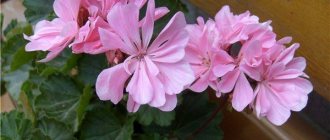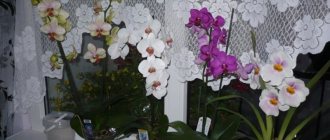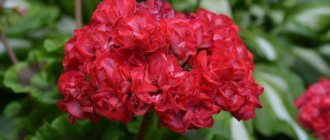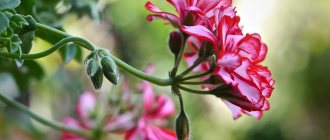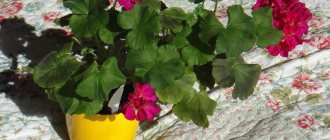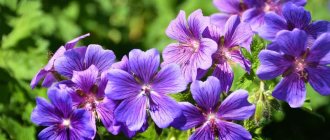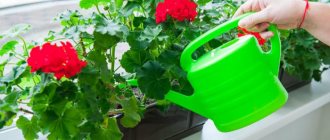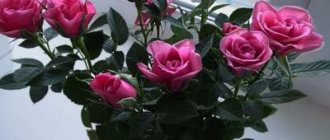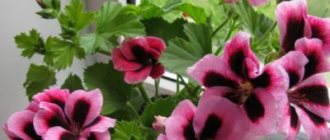A plant native to South Africa conquered the European continent already in the 16th century. Pelargonium or geranium (family Geraniaceae) has long become our favorite indoor and balcony plant.
Pelargonium on the balcony
White pelargonium
It is rapidly spreading throughout the globe, becoming one of the most popular plants. They love geraniums for their decorativeness, unpretentiousness, easy propagation and medicinal properties. And there are so many types and varieties that everyone can choose according to their taste and color.
Pelargonium in a concrete pot
Pelargonium bloom
Features of the classification of pelargoniums
There is no harmonious classification of pelargoniums into groups, species and varieties in the world. There are classifications proposed by different breeders, but none of them can be called perfect. This is due to the fact that in the last century many new varieties were bred: dwarf and variegated forms, with two-color and double flowers.
Pelargonium in home garden decor
Pelargonium in the courtyard of the house
Pelargoniums are most often divided into the following groups:
- Zonal.
- Ivy or balcony.
- Large-flowered (beautifully flowering) or royal.
- Angels.
- Uniques.
Fragrant pelargonium stands out as a separate group, which is not distinguished by beautiful blooms, but has carved leaves. To a greater extent, it can be attributed to decorative leafy forms. But this division is conditional, since fragrant pelargoniums include different species.
Variegated geraniums are also considered as a separate group, but again among these plants there are ivy-leaved and fragrant ones. We will introduce you to the most interesting varieties of this common and unpretentious indoor crop. So, we present varietal pelargoniums.
Geranium
Pelargonium in a pot
Pelargonium in the living room interior
The benefits and harms of geraniums in the home
There are many types of pelargonium; in terms of decorative value, it is a real interior decoration. Is it possible to keep geranium at home, how beneficial or harmful is it? There are arguments for both the pros and cons of the presence of pelargonium in homes.
Pelargonium in the house
Useful properties of geranium
| Direction | Description |
| Microclimate | The phytoncides released by leaves refresh and disinfect home air. This excludes family members from getting colds and infectious diseases. Inhaling the fragrant scent of pelargonium calms the nervous system and relieves irritability. It is also an excellent remedy for headaches and insomnia. |
| Medicinal properties | In folk medicine, pelargonium is used for healing decoctions: · from the root – for epilepsy; · from leaves – from rheumatism, gout, gastritis, diarrhea; · from the aerial part and roots - for gargling for sore throats and colds; for stomatitis and toothache. |
| Cosmetology at home | To restore the epidermis during acne and skin rashes, masks using crushed geranium leaves are recommended. |
| Aromatherapy | Essential oils that have a tonic effect are prepared from parts of the plant in pharmacology. In small quantities, the drug is used to treat: otitis, rhinitis, sore throat; frostbite and burns; · blood pressure and cardiovascular diseases; · hormonal imbalances. Essential oil will help relieve menstrual pain. A few drops added to water is a good remedy for cellulite, skin rashes and acne. |
Important! Preparations based on geranium should not be taken on an empty stomach. Essential oils should not be used for more than 3 weeks.
Geranium essential oil
Despite this list of advantages, in some cases pelargonium can cause harm when:
- chronic diseases of the gastrointestinal tract;
- acute gastritis and ulcers;
- increased blood viscosity;
- thrombophlebitis;
- pregnancy and breastfeeding.
Elderly people and children are not recommended to take drugs containing pelargonium orally. Only external use is allowed, taking into account the absence of allergies to geranium esters.
Pelargonium royal: a person of “blue blood”
The most popular is pelargonium, the varieties of which are unique and decorative. The large-flowered plant includes royal pelargonium - one of the brightest and most sophisticated representatives of the species. Beautiful wavy petals and a flower diameter of 4-6 cm distinguish this species from other beautiful flowering forms. This is probably why it is the most capricious and demanding of growing conditions:
- after rooting of cuttings, flowering begins only in the second year;
- does not grow in the open air, in front gardens;
- flowering lasts only 3-4 months;
- in winter it should be at a temperature of +11-13C in bright light, otherwise the plant does not bloom in summer;
- In the spring it needs replanting, increasing the temperature and abundant watering.
Royal pelargonium requires special treatment at home, although most other varieties are not difficult to grow.
Pelargonium in the living room
Pelargonium in country style
Kinds
Fragrant pelargonium / Pelargonium graveolens
An evergreen, highly branched shrub, pubescent, growing up to 1 m in height. The leaves are pubescent, divided into 5-7 lobes, green. They smell nice. The inflorescences are umbrella-shaped, the flowers are numerous and pink. The flowering period is throughout the summer.
Pelargonium capitatum / Pelargonium capitatum
The species is represented by evergreen subshrubs, growing in height up to a little over 0.5 m. Shoots and leaves are pubescent. The shoots are straight. The leaves seem to be crumpled, divided into 3-5 parts, green. The inflorescence is umbellate. The flowers are sessile, grow in large numbers, and are pinkish in color (with shades of purple). Flowering period is mid to late summer. The leaves smell.
Fragrant pelargonium / Pelargonium odoratissimum
Shrub, does not shed leaves, short shoots. The leaves are up to 5 cm wide, heart-shaped, with slightly ragged edges, covered with very short and soft hairs, and smell very pleasant. The inflorescences are umbellate. Flowers are collected in 8-10 pieces, pink and white.
Pelargonium zonale / Pelargonium zonale
Evergreen meter-long subshrubs with pubescent and fleshy shoots. The leaves are usually entire and only sometimes slightly lobed, green in color with a brown border along the edge. Sessile red flowers are collected in multi-flowered inflorescences. Blooms from late spring to early autumn.
Pelargonium cucullatum
An evergreen pubescent shrub native to South Africa. Leaves on long petioles, green. The inflorescence is umbrella-shaped. The flowers are red-violet, numerous. The flowering period occurs at the end of summer - beginning of autumn. There are varieties with double leaves.
Pelargonium grandiflorum / Pelargonium grandiflorum
Evergreen meter-long shrub with a large number of branches. The leaves are either lobed or dissected, kidney-shaped, rounded, or slightly pubescent or without hairs. Up to 3 white flowers with red veins grow on a peduncle; flowers grow up to 3-4 cm in diameter. Flowering occurs in mid-spring - early summer.
Pelargonium curly / Pelargonium crispum
Evergreen shrubs with a large number of branches, grow up to 0.5 m. The leaves grow in two rows, the shape approximately resembles a heart-shaped, dense, the edges are ragged-wavy, jagged. Blooms in mid to late summer. Flowers grow on short stalks of two or three. The leaves smell nice.
Pelargonium inquinans / Pelargonium inquinans
One and a half meter evergreen shrub with fleshy shoots. The leaves are round, kidney-shaped, dark green. The inflorescences are umbellate. Pedicels are short. The flowers are red. Depending on care, it can bloom in late spring, summer, autumn and winter.
Pelargonium crithmifolium
These are succulent deciduous plants with thick creeping shoots. The leaves are divided into lobes, pinnately shaped and bluish in color, reaching 8 cm in length, and may be covered with hairs or may be hairless. The inflorescences are umbrella-shaped. Pedicels are 1.5-2 cm long, flowers grow in 5-6 pieces, white; pharynx with red spots.
Pink pelargonium / Pelargonium radens
Evergreen one and a half meter shrubs with a large number of pubescent shoots. The leaves are pubescent on both sides: with soft hairs below and hard hairs on top; the edges of the leaves are curved; the leaves are very deeply divided. They smell very nice. The peduncle is umbellate, pubescent. The flowers are pink with dark veins, growing several on a peduncle.
Angular Pelargonium / Pelargonium angulosum
Evergreen pelargonium growing up to 1 m in height. The leaves look a bit like an oak leaf, but the leaf lobes are wavy rather than straight. They grow on a short petiole. The inflorescence is umbellate. There are many flowers, most often bright red. With proper care, flowering occurs at the end of summer - mid-autumn.
Pelargonium quadrangular / Pelargonium tetragonum
This species is a deciduous shrub, growing up to 60-70 cm in height. The stems are straight, tetrahedral, light green or tinged with gray. The leaves are heart-shaped, petiolate, covered with sparse hairs, and grow up to 5 cm wide; The edge of the leaf is reddish-brown. The flowers usually consist of 5 white petals (with a cream or pink tint) - 3 large petals at the top, and 2 smaller ones at the bottom.
Pelargonium corymbose / Pelargonium peltatum
An ampelous evergreen shrub. Shoots are pubescent or bare. The leaves are fleshy, thyroid-shaped, shiny, green, also pubescent or glabrous, divided into five lobes, the edges are smooth. The flowers are white, pink, red, collected in groups of several in umbrella-shaped inflorescences. Blooms from mid-spring to late summer.
Pelargonium ivy-leaved: ampelous beauty
Drooping, thin, branched stems make it possible to classify this plant as a hanging plant. Pelargonium ivy is distinguished by a fleshy and glossy leaf blade, reminiscent of an ivy leaf in shape. Flowers form umbrella inflorescences of different colors: white, pink or purple. There are unusual varieties with bronze or variegated leaves.
Ampelous pelargonium looks best in flower pots or hanging boxes. The drooping stems end in long pedicels strewn with flowers, including double forms. This beautiful indoor flower grows in flower beds into a continuous carpet of colorful bushes.
Pelargonium in a plaster pot
Geranium in a flowerpot
Botanical description and history
The homeland of fragrant geranium is South America . You can find the plant in South Africa, Mozambique, and Zimbabwe. It was brought to Europe in the 17th century. Geranium took root in Great Britain, where nurseries of this fragrant crop were created. The flower appeared in Russia in the 17th-19th centuries, where it was grown in the greenhouses of noble people.
Fragrant geranium has become widespread worldwide due to its unpretentiousness and adaptation to new local conditions. The fragrant plant can be grown in pots and containers. In summer it is used to decorate terraces, paths, flower beds, and mixborders.
Pelargonium fragrant: fragrant “Cinderella”
Pelargonium aromatica is distinguished by its aroma and is used to produce geranium oil. If you rub the leaf, the aroma will intensify. The leaf blade is heavily indented, so it does not look like a leaf of indoor geranium. It blooms modestly, and the bushes, growing up to a meter, are not particularly decorative. Although there are attractive varieties, but again due to the leaves, not the flowers.
Can be used as a seasoning for dishes, for the production of drinks and sweets. The species includes about 100 varieties, each of which has a special aroma. And it’s not scary that this species practically does not bloom. The main thing is that it produces a fragrant oil with different aromas.
Pelargonium in the kitchen interior
Where and how to plant it?
First you need to prepare the pot, focusing on the volume of the roots. The most suitable is a medium-sized pot , with a diameter of 15 cm. If you take a container that is too large, the planted plant will begin to fill the empty space with roots, as a result of which the decorative appearance of the flower will deteriorate.
A clay pot is perfect for fragrant pelargonium, as this material allows air to pass through perfectly, so the air will not become sour and waterlogged.
It is best to carry out planting work in the spring. To fill the pot, you can use either a purchased substrate or one prepared by yourself. The planted plant should be kept in a shaded place with moderate temperature conditions.
Tulip geranium: an indoor miracle
Tulip pelargonium can be proud of its history - there is a secret in its creation. She was bred at Andrea's Nursery (a family nursery in Boston). In 1966 it was presented at the exhibition as a new hybrid. But many consider this species to be simply a mutation, because without proper care it loses its decorative qualities, becoming the same as ordinary domestic pelargonium.
Pelargonium on the loggia
It is interesting for its medium-sized (up to 1 cm) flowers, reminiscent of an unopened tulip. The inflorescence, which can contain up to 50 flowers, looks like a chic bouquet. Differs in shades from delicate to rich, from pink to burgundy. The inside of the flower is more brightly colored. The leaves are interesting because they are tough and shiny. Among these geraniums there are plants from 30 to 70 cm tall.
Pelargonium, the species of which never cease to amaze, remains one of the most beloved indoor plants. In addition to abundant and long-lasting flowering, it has bactericidal properties, purifying room air from ubiquitous microbes.
What is it and characteristics of appearance
Fragrant geranium is a perennial that looks like a branched bush 1 m high. The plant has a well-developed root system. The leaf blade is bright green, and the flowers are small and pale pink. Is there a geranium that doesn't bloom? Some varieties of fragrant geraniums do not bloom, but they look attractive due to the decorative appearance of the leaves and their pleasant aroma. After flowering, a fruit-box is formed in which the seeds ripen.
The unusual smell of geranium is the result of the presence of small glands that are located on the outer and inner sides of the leaf blade. They look like fine hairs. The glands contain essential oil. The aroma spreads when touching the leaves. Simply rub them with your hands to create a lasting aroma of rose, lemon, mint or cinnamon.
Fragrant geranium distributes phytoncides in the room, which have an antimicrobial effect and normalize sleep. The leaves of the most fragrant indoor plants contain essential oils, flavonoids, and organic acids, which are widely used in medicine, cooking and perfumery.
More information about the medicinal and beneficial properties of fragrant geranium, as well as contraindications and uses of the plant can be found here.
Beauty pelargonium: care at home
If you follow simple rules for caring for this crop, it will delight you with its well-groomed appearance and abundant flowering, and its cultivation will become a pleasure.
Pelargonium on the window
Pelargonium at home prefers the following care:
- Watering rules: in summer it likes abundant bathing of the roots, but not spraying. It is especially undesirable to spray the inflorescences. We water every other day, but make sure that moisture does not accumulate in the pan. The rule here is appropriate: it is better to underfill than to overfill. In winter, pelargonium, watering of which is reduced to once a month, rests and gains strength for summer flowering.
- Light rules: for beautiful and long flowering, for the stems to be thick and the leaves to be juicy, you need a lot of light. If the geranium is located on a south window, then it is advisable to shade it a little from the direct rays of the sun. In winter, you can add artificial lighting. It will not bloom in a shaded place; the stems will stretch and the leaves will fade.
- Comfortable temperature: During growth and flowering, indoor crops need warmth. She feels good at t= +20-25C. From October to February there is a period of rest and during this period the optimum temperature is +12-15C.
- Air humidity mode: the air in the apartment should be moderately humid. Indoor pelargonium loves fresh air, access to which must be provided to it.
- Nutrition rules: geraniums need to be fed during the period of active growth - from spring to autumn. Feeding is carried out 2 times a month. Like any other crop, pelargonium needs nitrogen for abundant lush foliage, potassium and phosphorus for long and bright flowering. Fertilizers should be applied in liquid form to slightly moistened soil. There is a special fertilizer for pelargonium - Pelargovit, which is used according to the instructions.
You can use various organic substances: wood ash, infusion of bird droppings or herbs, humus. Therefore, the question of how to feed geranium is not particularly pressing. The main thing is to dilute fertilizers in the right proportion.
Now it’s clear how to care for pelargonium. The question remains how to properly propagate and plant it.
Pelargonium in a wicker pot
Landing
Garden geranium is an easy-to-grow perennial that quickly adapts to different living conditions. Tolerates different types of soil well, except wet and rocky.
Choosing a planting site, soil requirements
These perennials can be planted in almost any corner of the garden. Some species love the sun. Some species - Geranium macrorrhizum, Geranium phaeum - can withstand shade without problems, but the more shade, the less they bloom. We provide this information when describing individual species below.
Geranium can grow in a variety of soils, but does not like wetlands. Grows well even on poorly fertile sandy soil.
Most of all, geranium loves soils:
- fertile;
- permeable, well drained;
- with a slightly alkaline or neutral pH level;
- some species love soils with a high calcium content - blood red, Renarda, Dalmatian, Endrisa
Landing
Geranium seedlings can be purchased at a garden store. They are bought in containers, which makes them take root faster. Geraniums are planted in open ground when warm weather sets in - in May.
Depending on the type, geraniums are planted according to different schemes; on average, 8-14 plants are planted per 1 m² - in this density they look most beautiful.
Before planting, dig up the area; you can add compost during the digging, especially on weak soils. You need to select all the weeds and level the area.
Blood red geraniums should be placed quite tightly next to each other. The optimal interval is 10 pieces per 1 square meter. It grows quickly, but cuttings bought in stores or divided are quite small, so they can be planted very densely.
Basic secrets of reproduction
There are no special secrets here, but there are three main methods of reproduction.
Cuttings
The simplest and most accessible method is cuttings. Cuttings can be cut in March-February or July-August. The cut stalk should be 5-7 cm in size with 2-3 leaves.
It is withered a little (allowed to dry, but not dry out) and planted in the substrate. Abundant watering is needed, but should not be covered. After about a month, the cuttings will take root and can be planted in a separate container.
You can simply put the shoot in water and get a small plant with a root system. If you are worried that your pet will not grow roots, add growth stimulants to the water, for example, Kornevin.
Pelargonium in a hanging pot
Seeds
Pelargonium grows from seeds at home. They begin to germinate in February-March, laying them out on moist soil and lightly sprinkling them with soil. We maintain room temperature, cover the container with film, and periodically moisten the soil.
Shoots appear quickly, after about 2 weeks. They are dived and placed in a cooler room with good lighting. Then you can plant the pelargonium in a pot, placing it in the light.
It blooms in the first year after planting, but even a small plant does not bloom in the shade.
Pelargonium in Provence style
Dividing the bush
How to propagate pelargonium by dividing the bush? When the pot for the plant becomes cramped, you can divide the geranium into 2-3 parts, planting each in a separate container. Geranium takes root quite easily, so problems should not arise with this method of propagation.
Pink pelargonium
Pelargonium in the garden
Diseases and pests
Geranium has good disease resistance. She can still get sick and often this is due to improper care. Sometimes it happens that the base of the stem of a young bush turns black - this is black rot. This plant disease cannot be treated. Therefore, the affected plant is burned and the soil is changed to another.
To prevent the appearance of gray and black rot on the roots, do not let the liquid in the pot stagnate. Pests that may appear include mites, aphids and whiteflies. When aphids or mites appear on a flower, then you need to prepare an infusion of tobacco, chamomile with green soap and wipe the plant and leaves with it, including the back side.
After 3 hours, the bush should be rinsed with water. To rid geraniums of whiteflies, the following drugs are used alternately: Actellik, Confidor, Bison, Fufanon. After all, it is not easy to destroy larvae and adult whiteflies.
How to plant a plant correctly?
Planting pelargonium is traditional, as for most indoor crops:
- The flower pot should match the size of the plant.
- There are drainage holes at the bottom to allow excess moisture to drain into the pan.
- If you plan to rearrange the plant, it is better to use a plastic container for planting.
- Select the soil: it should be loose, dry well and contain organic matter. It is better to use good quality purchased soil.
- Pour the soil mixture into the pot, making a hole in the middle for the roots.
- Pour water into the hole, place the roots of the plant and cover with soil.
- Place the plant planted in this way in the designated place.
- If the geranium does not bloom for a long time, find a lighter area in the apartment for it.
If the pot for planting the crop is not new, then it must be thoroughly washed and disinfected with a solution of potassium permanganate. Such a pot can harbor bacteria that can infect the plant planted in it.
Pelargonium Tuscany
Garden pelargonium
The pelargonium flower is a unique ornamental and medicinal plant. It will bring bright, rich colors into the house and rid the air of pathogenic bacteria. It will make your home cozy and green, without demanding special treatment in return. This is probably why beautiful geraniums peek out from many windows in houses.
Pelargonium zonal
Growing and care
Garden geranium is one of the most undemanding plants and is suitable even for beginner gardeners and does not require special care. It tolerates drought and frost quite well. The species is highly resistant to pests and fungal diseases.
Watering, fertilizing
Different species have slightly different soil moisture requirements.
On light soils, geranium can be fed by choice:
- organic fertilizer (compost);
- mineral fertilizer for flowering plants with a high content of phosphorus and microelements, so that it blooms better (this is especially important for large species).
For example, the blood-red and large-rhizoma species tolerate a lack of water well, so you don’t have to worry about watering them. They tolerate drought much better than stagnant water, so you should limit watering in shady areas and ensure drainage. They thrive on less fertile soils, so fertilizers are also not needed. These are ideal species for beginner gardeners and people with little experience caring for plants.
Trimming
It is worth remembering to remove faded inflorescences. This makes the plants more beautiful and prevents the bushes from sowing ripe seeds.
When the geranium has faded, it is worth pruning it - the shoots are cut to half their height (about 15 cm above the ground), soon the plants will be covered with young leaves and new flowers. This pruning is especially recommended for lush species. The easiest way to trim plants over a larger area is to use a hedge trimmer. After feeding with fertilizers, some species, such as meadow and forest geraniums, will bloom a second time on new shoots.
Late fall pruning is not recommended, especially for evergreen species.
Wintering
Most types of geranium are frost-resistant. Red, large-rhizome species and many others do not need shelter - they feel good under the snow.
Diseases and pests
In wet weather, the plant can be affected by fungal and bacterial diseases. It is necessary to immediately remove diseased leaves, preventing the spread of infection, and treat the plant with a fungicide according to the instructions.
Fungal diseases affecting geranium:
- Downy mildew (Plasmopara geranii) - brownish-purple spots are visible on the upper side of the leaf, a whitish coating appears on the lower side, where the spots are present. Leaves die at the site of infection.
- Leaf spot (Cercospora geranii, Phyllosticta geranii, Ramularia geranii, Septoria expansa).
- Rust (Puccini spp.)
Bacterial diseases affecting geranium:
- Bacterial leaf spot (Pseudomonas erodii) – small yellow-brown spots are visible on the leaves, which increase in size and turn brown over time. A yellow frame appears along their edges. Infected leaves die.
Geranium is affected by some pests:
- Chrysanthemum nematode (Aphelenchoides ritzemabosi) - dark brown spots appear on the leaves, limited by veins.
- Spider mite (Tetranyus urticae) – yellowish or reddish-purple discoloration appears on the leaves.
- The sawfly (Protemphytus carpini) is a hymenopteran insect whose larvae gnaw holes in the leaves.
The healing properties of homemade geranium for humans
Indoor geranium helps normalize blood pressure. As practice shows, it is enough to attach a small leaf of such a plant to your wrist. This fragrant plant also very effectively stimulates blood flow and helps normalize heart rate. Pelargonium is very widely used for the treatment of acute respiratory viral diseases. For this purpose, tincture or freshly squeezed juice is used.
Pelargonium helps very well with otitis media, for which you just need to roll up a leaf of the plant and place it inside the inflamed ear.
An indoor flower can also help in the prevention and treatment of the following diseases:
- osteochondrosis;
- radiculitis;
- insomnia;
- migraine;
- chronic fatigue;
- toothache;
- stomach upset;
- purulent wounds.
The plant used for medicinal purposes must be completely healthy and well developed, without signs of damage by diseases or insect pests.
Features of plant flowering
Geranium flowers require a lot of sunlight to form. If the pot is placed on a north window in mid-latitudes, then flowering may not occur at all. The optimal length of daylight hours is 14 hours.
- Period of activity and rest
Geranium can bloom all year round if there is 14 hours of daylight. In the absence of lighting, the first flowers will bloom in April, and the last ones in October.
- Types and shape of flowers
The traditional corolla shape for fragrant geraniums is 5-petal. Some varieties of pelargonium bloom with double and semi-double flowers. The umbrella inflorescence of different varieties consists of 3-25 buds.
Fragrant geranium flowers are not the main thing
Basic requirements for caring for garden geraniums
Watering is the first part of care. It should be regular, but you shouldn’t “water” the plant. It needs abundant watering only after planting itself, for rooting, and during the dry season. In principle, you just need to keep an eye on the garden geranium - if its leaves begin to droop, this indicates a lack of moisture, which means water it urgently!
Loosening and mulching are perhaps the most necessary components of care, since geranium loves light and loose soil. You can plant ground cover plants next to it - they also “loose” the soil well. If the soil fertility in the area is still low, then to prevent the soil next to the flower from turning into crust after watering, it is better to walk nearby with a flat cutter.
Geranium pruning is carried out periodically, mainly by removing yellow, dry leaves, dead shoots, and broken stems. This will both improve the health of the bush and promote growth. Pruning prolongs the flowering of the bush.
Geranium does not need fertilizing as such. When planting, peat and compost are enough for her. But if you really want to, you can use complex organomineral fertilizers, but do not overuse them. Geranium also has a negative attitude towards transplants.
Garden geraniums also have two misfortunes - bacterial rot and wilting. But if the agrotechnical process is fully followed, and care is carried out correctly and regularly, then these diseases are not terrible for the bush.
Fragrant geranium - what is it?
According to the botanical classification, geranium (lat. Geranium) is a herbaceous perennial plant that prefers dry soils, sometimes winter-hardy. The leaves are palmate or palmately lobed, on long petioles, always with pubescence.
scented geranium
The color of the flowers, consisting of five petals rounded at the ends, can be white, pink, purple, blue. The bushes are branched with shoots directed upward or creeping.
Geranium leaf
Fragrant pelargonium (lat. Pelargonium odorata) is an independent representative of the Geranium family with a different chromosome set than the classic geranium. These plants form bushes from erect shoots or drooping (ampeloid). The leaves are pubescent (zonal varieties), as well as smooth, fleshy and shiny (ivy-leaved varieties).
Flowers come in all kinds - five-petalled, semi-double, double, resembling roses (rosebundae). The color of the petals is almost any, single-color, two-color, multi-color, but never blue or purple.
Leaves of ivy-leaved variegated pelargonium (Edinburgh variety)
Description and characteristics of appearance
Geranium fragrant is a trade name. On the price tags you can see the words: colon, perfume, most fragrant. Plants in this group may actually belong to pelargoniums or geraniums, but they are always distinguished by their inexpressive flowering and the bright, memorable aroma that the foliage produces, just by touching it.
Fragrant geraniums look different. Their foliage can be monochromatic - light or dark green, with a characteristic spot in the middle of the rounded leaf plate (zonal pelargoniums), but the most spectacular are varieties with openwork pinnately dissected foliage and variegated ones, combining several shades at once (yellow, green, pink, purple, etc.). d.).
Fragrant pelargonium variety Lady Plymouth
History of origin or selection
There are a great many varieties of geraniums (over 400 species). They are found in nature almost all over the globe.
For example, in Greece the species Pelargonium graveolens (geranium graveolens) grows, which served as the ancestor for the varieties:
- Gray Lady Plymouth,
- Cinnamon Rose,
- Graveolens and others.
The variety with curling leaves is known as Pelargonium graveolens cv "Bontrosai".
All this serves as extensive genetic material for breeders, who regularly present the latest developments.
For reference! Modern fragrant varieties are distinguished by their unpretentiousness, compact crown, pleasant aromas and useful ability to improve the health of the air in the house, repel flies and mosquitoes.
The non-capricious culture is suitable for novice gardeners, but in addition to the benefits, there are contraindications for allergy sufferers.
Geranium and family happiness
| Flower shade | Superstitions |
| Pink | Pelargonium brings love, happiness into the home and strengthens marriage bonds. The plant will protect against quarrels and love spells of evil rivals, saving spouses from separation. Pink geranium will help a guy to get married successfully, and a girl - not to stay too long as a bride. If the plant has bloomed, it's time to prepare for the wedding. Creative people are guaranteed recognition of their talent, and down-to-earth people are guaranteed success in business. |
| White | Helps cope with infertility. This pelargonium is recommended to be placed in the bedroom of spouses who are unsuccessfully trying to conceive a child. If the plant produces lush flowers, expect a new addition to the family soon. White color will protect an innocent girl from evil spirits and abuse. If you place geranium in a children's room, the baby will grow up calm and his sleep will be sound. |
| Lilac | When the geranium blooms magnificently, expect strong friendship for centuries in your home. This is also a sign that the owner will be surrounded by great honor and respect. |
| Red | This is a symbol of fidelity and true love. Guarantees reciprocity of feelings for young people. Helps married women maintain beauty and youth. If you carry a bag of dried red petals with you, it’s easy to meet your betrothed. |
Symbol of innocence
Based on the superstitions described, one can hope that pelargonium of any shade will attract love into life and make people happy.
The real point is that geranium in the house is an attribute of aromatherapy. It is the ethereal smell that creates a relaxing, cozy atmosphere, setting up home inhabitants to be positive.
Geranium is withering away
The more magnificent the plant, the more negativity it managed to neutralize. If pelargonium has stopped blooming and is withering, the reason for this is not a violation of agricultural technology conditions, you should think about the reasons:
- There are too serious problems in the house that geranium cannot cope with on its own. Owners need to analyze the events of recent days (weeks), which attracted negativity into the family.
- Perhaps the day before there were many guests in the house, among them there were ill-wishers, envious people, or people with bad energy.
- Pelargonium also reacts sensitively to the physical condition of family members. The stunted state of a flower may indicate an upcoming disease, even if it is still at a latent stage. Red geranium can even predict cancer.
- Geraniums can also wither because someone else’s item, which is liable to damage, has entered the house. If the conspiracy is strong, it is difficult for pelargonium to cope with such energy.
How true are the signs of why pelargonium withers, each owner will decide for himself. But it doesn’t hurt to analyze your life and relationships with others.
Pelargonium is withering away
